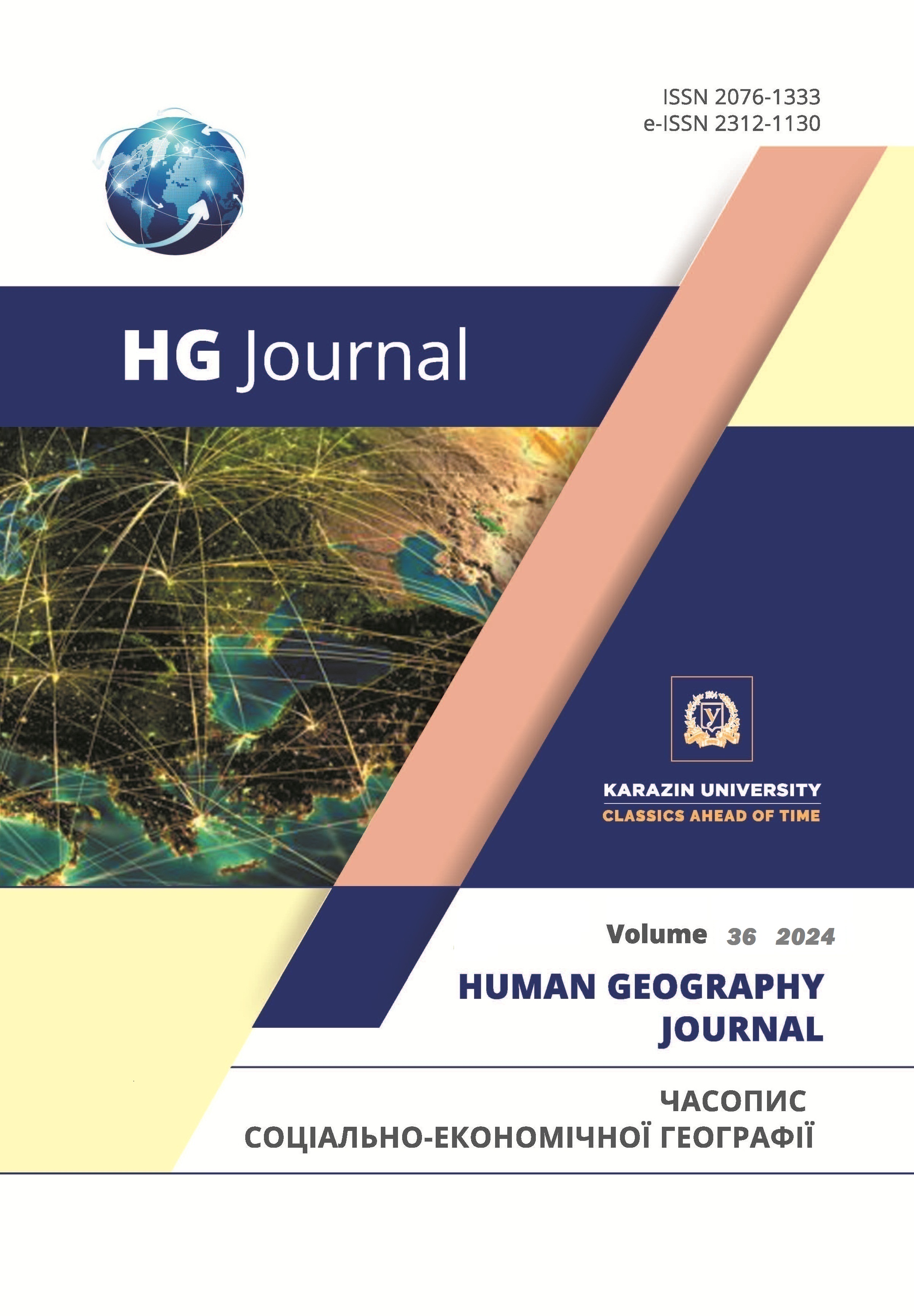Суспільно-географічні особливості дослідження транспортної доступності закладів дошкільної та середньої освіти міст Харків та Варшава
Анотація
Ефективна транспортна система є однією з важливих елементів економічно розвинутого міста. Якість транспортної інфраструктури та забезпечення логістичних послуг насамперед сприяють доступності або легкості, з якою люди можуть дістатися до основних місць призначення, таких як робота, заклади охорона здоров’я та освітні заклади, використовуючи певний вид транспорту, або їх комбінацію. В роботі проведено суспільно-географічний аналіз транспортної доступності дошкільних та загальноосвітніх навчальних закладів у Харкові та Варшаві. Наведено особливості методики дослідження транспортної доступності за допомогою геоінформаційних систем QGIS 3.16 та ArcGis 10.7. на основі даних відкритого ресурсу OpenStreetMap. На основі просторового ГІС-аналізу розміщення закладів дошкільної та середньої освіти було побудовано буферні зони, які покривають територію в зоні 500-метрової (орієнтовно 5-хвилинної) доступності.
Встановлено, що міста Харків та Варшава мають добре розвинену транспортну інфраструктуру, у місті Харків у структурі пасажирообігу за видами транспорту превалює метрополітен, у місті Варшава – автобусний транспорт. Порівняльний аналіз доступність дошкільних навчальних закладів за усіма видами громадського транспорту в Харкові та Варшаві засвідчив, що в цілому за видами транспорту частка кількості закладів, розташованих у буферних зонах є фактично однаковою. Кількість дошкільних навчальних закладів у Варшаві в 3,5 рази більше, ніж у Харкові. В ході дослідження транспортної доступності загальноосвітніх навчальних закладів усіма видами громадського транспорту в Харкові та Варшаві встановлено, що в цілому за видами транспорту частка закладів, розташованих у буферних зонах, є майже рівною, кількість середніх навчальних закладів у Варшаві майже вдвічі більша у Харкові. Кількість навчальних закладів, розташованих у буферних зонах, становить майже 90%: із 215 шкіл 213 розташовані у буферних зонах громадського транспорту. Більшість навчальних закладів (99%) Варшави розташовані в буферних зонах автобусних маршрутів, що свідчить про широке охоплення цього виду транспорту. Метро забезпечує доступ до 27% шкіл міста. Значна частина шкіл (51%) у Варшаві знаходиться в буферних зонах трамвайних маршрутів, що підвищує доступність навчальних закладів.
Загалом міста Харків і Варшава характеризуються доволі високим рівнем транспортної доступності до освітньої інфраструктури, оскільки понад 99% навчальних закладів розташовані в межах буферних зон громадського транспорту, що підтверджує ефективність транспортної інфраструктури міст щодо забезпечення доступу до закладів дошкільної та середньої освіти.
Завантаження
Посилання
Behbahani, H., Nazari, S., Jafari K., M., & Litman, T. (2019). A conceptual framework to formulate transportation network design problem considering social equity criteria. Transp. Res. Part A: Policy Pract. 125(C), 171-183.
De Palma, A., Lindsey, R., Quinet, E., & Vickerman, R. (2017). The Routledge Handbook of Transport Economics (Edited ByJonathan Cowie, Stephen Ison). – 1st Edition, 2017, 460.
Fan, W., & Machemehl, R.B. (2011). Bi-level optimization model for public transportation network redesign problem: Accounting for equity issues. Transp. Res. Rec. 2263 (1), 151-162. https://doi.org/10.3141/2263-17.
Malysh, N. (2016). Transport infrastructure of Ukraine under the conditions of implementation of the Association Agreement with the EU. Development of the accounting, analysis and audit system in Ukraine: theory, methodology, organization: materials Vseukr. of science conf., Kyiv: NASOA, 146-149 [in Ukrainian].
Niemets, L., Sehida, K. et.al. (2017). Innovatsiyno-investytsiynyy potentsial yak osnova konkurentospromozhnosti (na prykladi Kharkivsʹkoyi oblasti): kolektyvna monohrafiya [Innovation and investment potential as the basis of competitiveness (case study of Kharkiv region, coll. monograph. Kharkiv], V.N. Karazin Kharkiv National University, 2017, 520 p. [in Ukrainian].
Nosovska, O. (2014). Problems and prospects for the development of transport infrastructure of Ukraine. Bulletin of the Pryazovsky State Technical University, 27, 5-14 [in Ukrainian].
Official website of Warsaw City. Retrieved from https://ua.um.warszawa.pl/ [in Ukrainian].
Official website of Kharkiv City Council, Mayor. Retrieved from https://www.city.kharkov.ua/ [in Ukrainian].
Official website of the Main Department of Statistics in the Kharkiv region. Retrieved from http://kh.ukrstat.gov.ua/
OpenStreetMap. Retrieved from https://www.openstreetmap.org/
OverpassTurbo. Retrieved from https://overpass-turbo.eu/
Public transport step by step. Warsaw Public Transport. Retrieved from https://www.wtp.waw.pl/en/public-transport-step-by-step/ [in Ukrainian].
Raza, A., Zhong, M., Akuh, R., & Safdar, M. (2023). Public transport equity with the concept of time-dependent accessibility using Geostatistics methods, Lorenz curves, and Gini coefficients. Case Studies on Transport Policy, 11, https://doi.org/10.1016/j.cstp.2023.100956
Shiba, O. (2016). Strategy for the development of transport infrastructure of Ukraine in the conditions of European integration. Black Sea Economic Studies, Part 8, 35-40 [in Ukrainian].
Spatial analysis of vector data (Buffer). QGis documentation. Retrieved from https://docs.qgis.org/3.4/ru/docs/gentle_gis_introduction/vector_spatial_analysis_buffers.html
Stachyra, R., & Roman, K. (2021). Analysis of Accessibility of Public Transport in Warsaw in the Opinion of Users. Postmodern Openings, Editura Lumen, Department of Economics, 12(3), 384-403.
Warsaw’s transport. Retrieved from https://yavpohode.net/files/warsaw-strefa [in Ukrainian].
Wu, T.H. (2014). Research on layout planning of town center for public service facilities configuration. Dev. Small Cities Towns, 11 (2014), pp. 39-47.
ZTM annual reports. Public Transport Authority in Warsaw. Retrieved from https://www.ztm.waw.pl/raporty-roczne-ztm/ [in Ukrainian].
Авторське право (c) 2024 Кравченко К., Шпак Є., Хабусєв Є.

Цю роботу ліцензовано за Міжнародня ліцензія Creative Commons Attribution 4.0.




